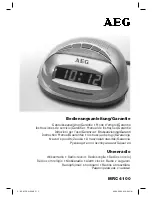
© 2004 Directed Electronics, Inc. Vista, CA
7
7
H
Ho
ow
w tto
o ffiin
nd
d ((+
+))1
12
2V
V iig
gn
niittiio
on
n w
wiitth
h yyo
ou
urr m
mu
ullttiim
meetteerr::
1. Set to DCV or DC voltage (12V or 20V is fine).
2. Attach the (-) probe of the meter to chassis ground.
3. Probe the wire you suspect of being the ignition wire. The steering
column harness or ignition switch harness is an excellent place to find
this wire.
4. Turn the ignition key switch to the run position. If your meter reads
(+)12V, go to the next step. If it does not read (+)12V, probe another wire.
5. Now turn the key to the start position. The meter display should stay steady, not dropping by more than a
few tenths of a volt. If it drops close to or all the way to zero, go back to Step 3. If it stays steady at (+)12V,
you have found an ignition wire.
The starter wire provides 12V directly to the starter or to a relay controlling the starter. In some vehicles, it is
necessary to power a cold start circuit. A cold start circuit will test exactly like a starter circuit, but it does not
control the starter. Instead, the cold start circuit is used to prime the fuel injection system for starting when the
vehicle is cold.
H
Ho
ow
w tto
o ffiin
nd
d tth
hee ssttaarrtteerr w
wiirree w
wiitth
h yyo
ou
urr m
mu
ullttiim
meetteerr::
1. Set to DCV or DC voltage (12V or 20V is fine).
2. Attach the (-) probe of the meter to chassis ground.
3. Probe the wire you suspect of being the starter wire. The steering column
is an excellent place to find this wire. Remember you do not need to
interrupt the starter at the same point you test it. Hiding your optional
starter kill relay and connections is always recommended.
4. Turn the ignition key switch to the start position. Make sure the car is
not in gear! If your meter reads (+)12V, go to the next step. If it doesn’t, probe another wire.
5. Cut the wire you suspect of being the starter wire.
6. Attempt to start the car. If the starter engages, reconnect it and go back to Step 3. If the starter does not
turn over, you have the right wire.
Most vehicles use a (+) brake light circuit. The (+) brake light wire is often found near the brake pedal. The same
wire can often be accessed in the kick panel or running board.
H
Ho
ow
w tto
o ffiin
nd
d aa ((+
+)) b
brraakkee lliig
gh
htt w
wiirree w
wiitth
h yyo
ou
urr m
mu
ullttiim
meetteerr::
1. Set to DCV or DC voltage (12V or 20V is fine).
ffiinnddiinngg aa ((++)) bbrraakkee lliigghhtt w
wiirree
ffiinnddiinngg tthhee ssttaarrtteerr w
wiirree








































